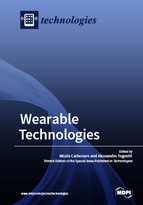Wearable Technologies
A special issue of Technologies (ISSN 2227-7080). This special issue belongs to the section "Information and Communication Technologies".
Deadline for manuscript submissions: closed (15 February 2018) | Viewed by 113665
Special Issue Editors
Interests: wearable sensors; human movement reconstruction; inertial sensors; rehabilitation
Special Issues, Collections and Topics in MDPI journals
Interests: biomedical engineering; sensing technologies; soft sensors; motion capture; data fusion; biomechanics; rehabilitation; wearable sensors and technologies
Special Issues, Collections and Topics in MDPI journals
Special Issue Information
Dear Colleagues,
Wearable technology will revolutionise our life in the years to come. The current trend is to augment ordinary body-worn objects—e.g. watches, glasses, bracelets, and clothing—with advanced information and communication technologies such as sensors, electronics, software, connectivity and power sources. These wearable devices can monitor and assist the user in the management of his/her daily life with applications that may range from activity tracking, sport and wellness, mobile games, environmental monitoring, up to e-health.
This Special Issue is intended to report the recent advances in the multidisciplinary field of wearable technologies and the important gaps that still remain in order to obtain a massive diffusion.
Articles in this Special Issue will address topics that include: wearable sensing and bio-sensing technologies, smart textiles, smart materials, wearable and implantable microsystems, low-power and embedded circuits for data acquisition and processing, data transmission, power supply.
Dr. Alessandro Tognetti
Prof. Dr. Nicola Carbonaro
Guest Editors
Manuscript Submission Information
Manuscripts should be submitted online at www.mdpi.com by registering and logging in to this website. Once you are registered, click here to go to the submission form. Manuscripts can be submitted until the deadline. All submissions that pass pre-check are peer-reviewed. Accepted papers will be published continuously in the journal (as soon as accepted) and will be listed together on the special issue website. Research articles, review articles as well as short communications are invited. For planned papers, a title and short abstract (about 100 words) can be sent to the Editorial Office for announcement on this website.
Submitted manuscripts should not have been published previously, nor be under consideration for publication elsewhere (except conference proceedings papers). All manuscripts are thoroughly refereed through a single-blind peer-review process. A guide for authors and other relevant information for submission of manuscripts is available on the Instructions for Authors page. Technologies is an international peer-reviewed open access monthly journal published by MDPI.
Please visit the Instructions for Authors page before submitting a manuscript. The Article Processing Charge (APC) for publication in this open access journal is 1600 CHF (Swiss Francs). Submitted papers should be well formatted and use good English. Authors may use MDPI's English editing service prior to publication or during author revisions.
Keywords
-
Flexible/stretchable electronics
-
Wearable sensors and biosensors
-
Smart textiles and smart materials
-
Implantable devices
-
Energy scavenging/harvesting
-
Low power circuits
-
E-health, rehabilitation engineering and assistive technologies
-
Internet of things
-
Wearable computing
-
Context recognition
-
Data processing and data fusion
-
Wireless and body area networks
Related Special Issue
- Wearable Technologies III in Technologies (5 articles)







